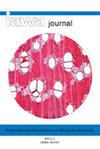不同林分密度对挪威云杉人工林木质部和韧皮部形成的影响
IF 3.5
3区 农林科学
Q2 FORESTRY
引用次数: 1
摘要
本文从木质发生和韧皮形成两个方面对挪威云杉生长的间伐效应进行了初步研究。选择了三个样地,通过商业前间伐将林分密度降低到1800棵/公顷(样地A;轻度间伐)和1300棵/公顷(地块C;严重减薄)。B区未进行造林干预,为对照变异(4500棵/公顷)。为了研究2020年生长季节的木质部和韧皮部形成,对3棵优势14岁挪威云杉进行了取样(微芯)。总分化时间为169.7±12.7 ~ 179.3±4.0 d。对照区B平均形成的木质部细胞数仅为140个,C区和A区分别有175个和200个成熟细胞。A样地生长速度最快。在A、B、C三幅图中,早期韧皮部、晚期韧皮部筛子细胞和轴向薄壁细胞的开始时间重合。但是,就韧皮部细胞的总增长量而言,图C的生长速度是3个样地中最快的。结果表明:疏伐处理对木质部和韧皮部细胞的总生长率、管胞和筛细胞的总生长率均有显著的正向影响;本文章由计算机程序翻译,如有差异,请以英文原文为准。
Effect of different stand densities on xylem and phloem formation in Norway spruce plantations
Summary Preliminary results of an investigation of the thinning effect on Norway spruce tree growth in terms of xylogenesis and phloemogenesis are presented. Three plots were selected where the stand densities were reduced by pre-commercial thinning to 1800 trees/ha (plot A; mild thinning) and 1300 trees/ha (plot C; heavy thinning) in February 2020. Plot B had no silvicultural intervention and represented a control variant (4500 trees/ha). Three dominant 14-year-old Norway spruce trees were sampled (micro-cored) for studying the xylem and phloem formation in the 2020 growing season. The total differentiation duration was determined to be around 169.7 ± 12.7–179.3 ± 4.0 days. The average number of xylem cells formed in control plot B was only 140 mature cells, plots C and A were determined to have 175 and 200 mature cells, respectively. Plot A had the fastest growth rate of all the plots studied. In all three plots (A, B, C), the beginning of the early phloem, late phloem sieve cells, and axial parenchyma cells coincided. Nonetheless, in terms of total phloem cell increase, plot C displayed the fastest growth rate among the three plots studied. The first results showed that the rate of total increment in both xylem and phloem cells, as well as the total number of produced tracheids and sieve cells, seem to be positively affected after the thinning application.
求助全文
通过发布文献求助,成功后即可免费获取论文全文。
去求助
来源期刊

IAWA Journal
农林科学-林学
CiteScore
3.40
自引率
15.80%
发文量
26
审稿时长
>36 weeks
期刊介绍:
The IAWA Journal is the only international periodical fully devoted to structure, function, identification and utilisation of wood and bark in trees, shrubs, lianas, palms, bamboo and herbs. Many papers are of a multidisciplinary nature, linking
 求助内容:
求助内容: 应助结果提醒方式:
应助结果提醒方式:


